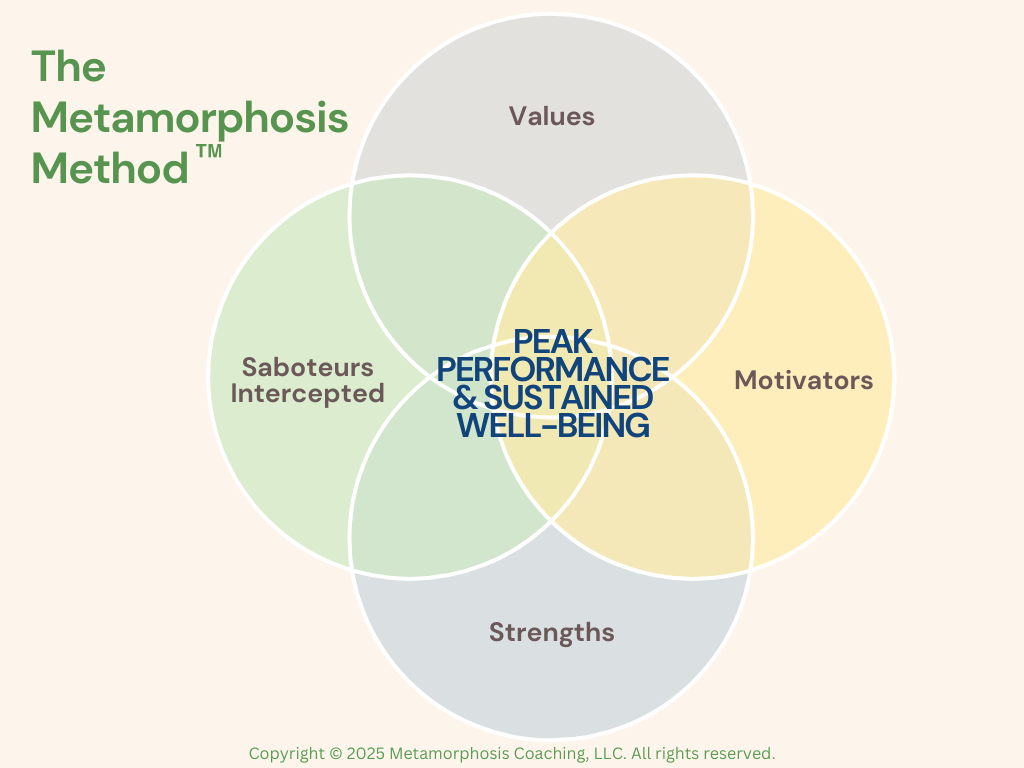Fuel for Success: Intrinsic and Extrinsic Motivators Drive Performance and Well-Being

Fuel for Success: Intrinsic and Extrinsic Motivators Drive Performance and Well-Being
by Doni Landefeld, Ph.D, ACPEC
What fuels your drive when challenges arise? What gets you out of bed in the morning, ready to tackle the day? Motivation—the powerful force behind our actions—is one of the most essential elements influencing our performance, fulfillment, and overall well-being. And yet, so many professionals lack clarity on what truly motivates them, leading to disengagement, frustration, and burnout.
Motivators: The Fuel for Action
Last month we unpacked core values, your North Star to peak performance and well-being. Working in tandem with value are your motivators – those driving forces behind your actions, propelling you toward goals.
Understanding your motivators, both intrinsic and extrinsic, is not just a theoretical exercise—it’s a strategic advantage. When you’re clear on what propels you forward, you make better decisions, set aligned goals, and create a work environment that enhances productivity and satisfaction. Let’s explore why this awareness matters and how to gain deeper insight into what drives you.
Why Motivation Matters
Motivation is the heartbeat of performance and well-being. It dictates whether we approach challenges with enthusiasm or resistance, whether we push through difficulties or retreat in frustration. When we understand what truly motivates us, we set ourselves up for greater success and fulfillment.
Here’s why understanding motivation is a game-changer:
1. It Fuels Sustainable Performance
Motivation isn’t about short-term bursts of energy—it’s about sustained engagement. When we’re aligned with our motivators, work feels more purposeful, and we’re naturally more productive. Without this alignment, we operate on willpower alone, which is finite and leads to exhaustion.
2. It Enhances Decision-Making
When we understand what drives us, we can make career and leadership decisions that align with our values and strengths. This clarity helps us avoid jobs, projects, or environments that drain us and instead move toward opportunities that bring out our best.
3. It Reduces Burnout and Stress
A misalignment between motivation and work responsibilities is a major contributor to burnout. If you’re driven by creativity but stuck in a rigid, bureaucratic role, exhaustion and frustration are inevitable. Conversely, when your work energizes you, stress becomes more manageable, and resilience increases.
4. It Strengthens Leadership and Team Dynamics
Great leaders don’t just understand their own motivators—they recognize what drives their teams. When leaders tap into both intrinsic and extrinsic motivators of their employees, they create an engaged, high-performing workplace where people feel valued and inspired.
“Don’t ask yourself what the world needs. Ask yourself what makes you come alive, and go do that.”
– Howard Thurman
Intrinsic vs. Extrinsic Motivation: Understanding the Balance
Motivation generally falls into two categories: intrinsic (internal) and extrinsic (external). While both play a role, their influence varies depending on the individual and the situation.
Intrinsic Motivation: The Inner Drive
Intrinsic motivation comes from within. It’s fueled by passion, curiosity, purpose, and personal satisfaction. When we engage in activities because they are inherently rewarding, we perform at our best and experience deep fulfillment. Examples include:
- A physician who finds joy in patient care beyond financial incentives
- A leader who is driven by the impact of mentoring and developing others
- A researcher who loves uncovering new knowledge, regardless of recognition
Extrinsic Motivation: External Rewards and Recognition
Extrinsic motivation is driven by external factors like financial incentives, promotions, awards, and societal recognition. While these motivators can be powerful, they are often less sustainable on their own. Examples include:
- Working hard to earn a bonus or salary increase
- Seeking a promotion or leadership title for status and recognition
- Completing a project to gain external validation or approval
Neither intrinsic nor extrinsic motivation is inherently better—the key is understanding what balance works best for you. While intrinsic motivation leads to deeper satisfaction, extrinsic rewards can provide necessary structure and reinforcement. Successful professionals and leaders know how to integrate both.
How to Gain Clarity on Your Motivators
Self-awareness is the foundation of understanding motivation. Here are three ways to gain deeper insight into what drives you:
1. Reflect on Peak Experiences
Think about a time when you felt highly engaged, energized, and fulfilled at work. What was happening? What aspects of the experience brought you joy or a sense of accomplishment? Identifying patterns in these experiences will reveal key motivators.
2. Assess Your Energy and Engagement
Pay attention to tasks that naturally energize you versus those that feel draining. If leading strategic discussions lights you up but repetitive administrative work depletes you, that’s a clue about what motivates you. Keeping a motivation journal can be a helpful tool in this process.
3. Use a Motivation Assessment
There are numerous assessments available that help pinpoint intrinsic and extrinsic motivators. Tools like StrengthsFinder, the Predictive Index, or our intrinsic/extrinsic inventory can provide deeper insights into what drives your performance and engagement.
Applying Motivation Insights to Your Work and Leadership
Once you have clarity on your motivators, the next step is to align your work and leadership approach accordingly. Here’s how:
- For Yourself: Seek out opportunities, projects, and roles that align with your motivators. If creativity fuels you, find ways to incorporate innovation into your work. If recognition is important, advocate for roles that allow your contributions to be acknowledged.
- For Your Team: Understanding what drives your employees allows you to lead more effectively. Instead of using a one-size-fits-all approach, tailor your leadership to align with their motivators. This fosters engagement, loyalty, and high performance.
- For Long-Term Growth: Motivation evolves over time. Reassess your drivers regularly and adjust accordingly. What motivated you five years ago may not be the same today—embracing this evolution is key to sustained career fulfillment.
Moving Forward with Your Motivators
Understanding your motivators is not just about boosting performance—it’s about aligning your work with what truly fulfills you. When we harness our motivation effectively, we experience greater engagement, resilience, and overall well-being. The clarity gained from this process is a strategic advantage, helping us navigate careers, leadership, and life with intention and purpose.
Are you ready to unlock your full potential? Start by identifying your key motivators and align them with your work—it’s the catalyst for long-term success and fulfillment. We can help you gain clarity on your intrinsic and extrinsic motivators.
We have a fun inventory to gain clarity on intrinsic and extrinsic motivators. Just click on the button below to get started.
Special Report:
How to be a Resilient Leader in this Challenging World. PLUS More Free Resources!

Sign up below and get your FREE "How to Be a Resilient Leader in This Challenging World" Report today!

